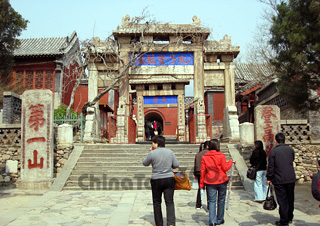 Zhongtian Gate on Mt. Tai
Zhongtian Gate on Mt. Tai The Inscriptions on Huge Rocks
The Inscriptions on Huge Rocks Old-style Constructions on Mt. Tai
Old-style Constructions on Mt. Tai Tour at Mt. Tai
Tour at Mt. Tai
In the long history of the Chinese nation, the Mount Tai has been considered as the head of the China's famous mountains. Though it is not very high - more that 5,000 feet above sea level, it occupies a rather high position in China's history and culture. As everyone knows, geographically Mount Everest is the highest mountain in the world; while, Mount Tai is the highest peak of Chinese culture.
The mountain is located in the middle of Shandong province and it is the highest peak in lower area of the Yellow River. Compared with the low plains and hills surrounded, it inspires us by its towering majesty and imposing solemnity. Where the mountain stands is one of the birthplaces of the Chinese civilization and our ancestors were born here. They also lived here, relying on the mountain to survive.
In ancient times, the mountain was called 'Mount Dai'. 'Dai' means great in ancient Chinese. 'Mount Dai' means a great mountain. Our ancestors thought that it was the highest mountain. Later gradually, Mount Tai was deified as the chief of China's mountains. The area of the moutain is 164 square miles. Around the main peak - Jade Emperor Peak, there are more than 100 smaller peaks, 98 ridges and 102 streams. All of these compose a wonderful spectacle of Mount Tai. When you climb the mount, the winding path may spring wide suddenly. When you reach the top and overlook from there, you can just enjoy a view of everything below you. A feeling of pride, boldness and generosity will surely fill your bosom.
One of the prominent characteristics of Mount Tai is the perfect combination of natural landscapes and humanities. It is located in the east and the east signifies birth and spring. Thus, it is the only famous mountain that received 'Fengshan', which was a holy ritual of the ancient Chinese emperor communicating with the heaven. Numerous emperors, poets and literators were attracted here and left many cultural relics. Besides temples and statues, there are over 2,000 carved stones. Among them, the one carved with 'the No.1 of the Five Sacred Mountains' is the symbol of Mount Tai.
'Five Sacred Mountains' is a blanket term for five famous mountains in China. They are the East Mountain - Mount Tai, the South Mountain - Mount Heng, the West Mountain - Mount Hua, the North Mountain - Mount Heng and the Central Mountain - Mount Song. The ancient Chinese named those mountains this way because they revered great mountains and rivers. According to the Chinese ancient myth, When Pangu, the ancestor of all things, died, his head and limbs turned into these five mountains. From the angle of altitude, Mount Tai only ranked the third among the five. However, thanks to Fengshan culture, it is honored as a sacred mountain and the symbol of Chinese national spirit. It is highly praised as an image of national prosperity, unity and oriental civilization and it represents the thought of 'Harmony'.
Varied ancient trees are grown on the Mount Tai. There are six cypresses planted by an Emperor of Han Dynasty (206 BC - 220 AD), older than 2,100 years old. Additional, there is also locust trees planted 1,300 years ago and pines planted 500 years ago. In 1987, it was listed as both a world natural and cultural heritage by UNESCO. It was the first place named as double heritage to the world.
![]() Entrance Fee: CNY 125 (Feb. to Nov.); CNY 100 (Dec. to Jan.)
Entrance Fee: CNY 125 (Feb. to Nov.); CNY 100 (Dec. to Jan.)
![]() Best Time to Visit: May
Best Time to Visit: May
![]() Transportation:
Transportation:
A. Visitors from other cities can take trains to Taishan Railway Station and take the tourism buses to Mount Tai;
B. Visitors can also take long-distance buses to Taian Long-distance Bus Station, take Bus No. 1, 2, 4, 5, 10, 11, 14, 18, 28 or 40 to Taishan Railway Station and then the tourism buses to Mount Tai.







